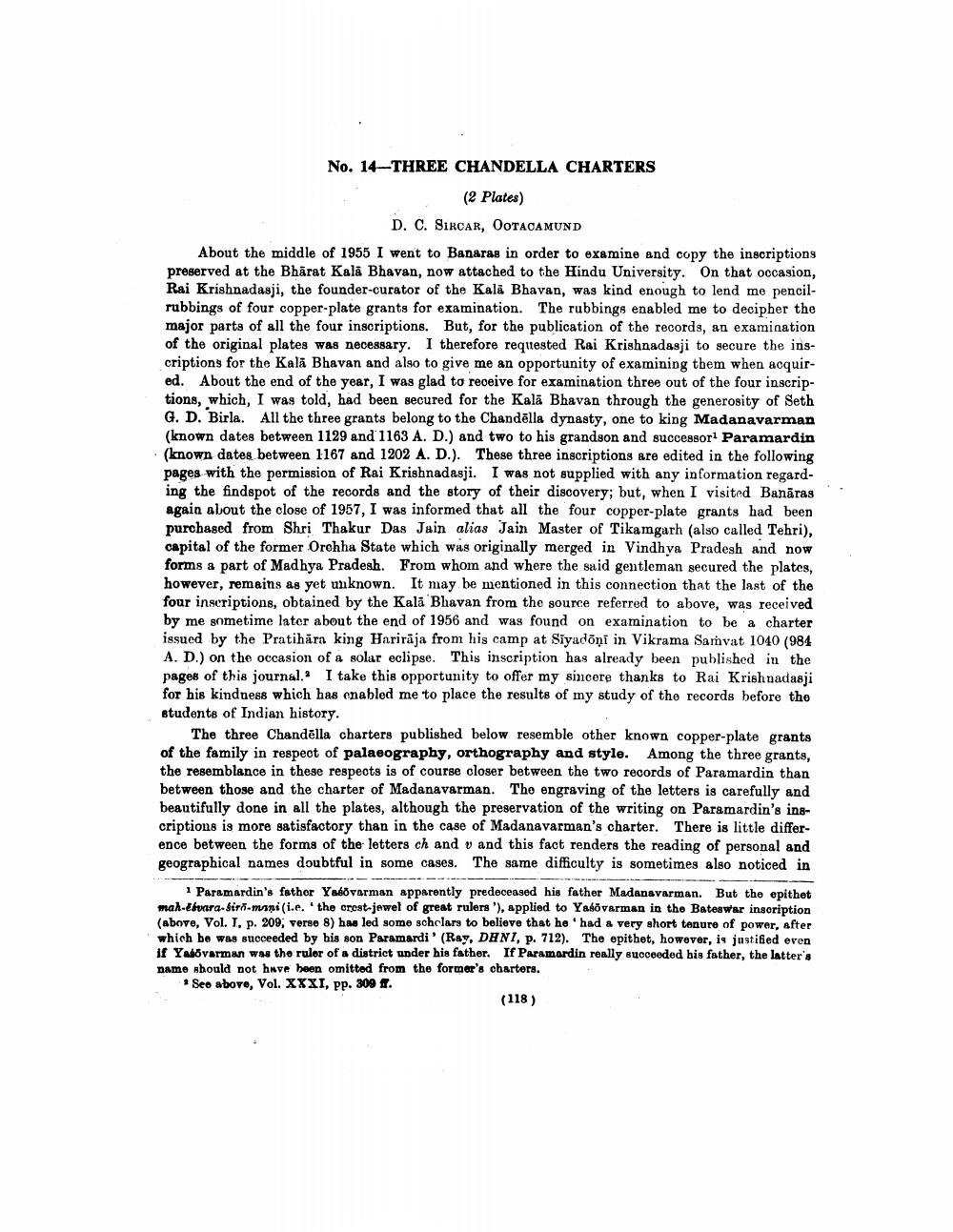________________
No. 14-THREE CHANDELLA CHARTERS
(2 Plates)
D. C. SIRCAR, OOTACAMUND About the middle of 1955 I went to Banaras in order to examine and copy the inscriptions preserved at the Bharat Kala Bhavan, now attached to the Hindu University. On that occasion, Rai Krishnadasji, the founder-curator of the Kala Bhavan, was kind enough to lend me pencilrubbings of four copper-plate grants for examination. The rubbings enabled me to decipher the major parts of all the four inscriptions. But, for the publication of the records, an examination of the original plates was necessary. I therefore requested Rai Krishnadasji to secure the inscriptions for the Kala Bhavan and also to give me an opportunity of examining them when acquired. About the end of the year, I was glad to receive for examination three out of the four inscriptions, which, I was told, had been secured for the Kala Bhavan through the generosity of Seth G. D. Birla. All the three grants belong to the Chandēlla dynasty, one to king Madanavarman
(known dates between 1129 and 1163 A. D.) and two to his grandson and successori Paramardin · (known dates between 1167 and 1202 A. D.). These three inscriptions are edited in the following
pages with the permission of Rai Krishnadasji. I was not supplied with any information regarding the findspot of the records and the story of their discovery; but, when I visited Banaras again about the close of 1957, I was informed that all the four copper-plate grants had been purchased from Shri Thakur Das Jain alias Jain Master of Tikamgarh (also called Tehri), capital of the former Orchha State which was originally merged in Vindhya Pradesh and now forms a part of Madhya Pradesh. From whom and where the said gentleman secured the plates, however, remains as yet unknown. It may be mentioned in this connection that the last of the four inscriptions, obtained by the Kala Bhavan from the source referred to above, was received by me sometime later about the end of 1956 and was found on examination to be a charter issued by the Pratihāra king Hariraja from his camp at Siyadoni in Vikrama Samvat 1040 (984 A. D.) on the occasion of a solar eclipse. This inscription has already been published in the pages of this journal. I take this opportunity to offer my sincere thanks to Rai Krishnadasji for his kindness which has enabled me to place the results of my study of the records before the students of Indian history.
The three Chandēlla charters published below resemble other known copper-plate grants of the family in respect of palaeography, orthography and style. Among the three grants, the resemblance in these respects is of course closer between the two records of Paramardin than between those and the charter of Madanavarman. The engraving of the letters is carefully and beautifully done in all the plates, although the preservation of the writing on Paramardin's inscriptions is more satisfactory than in the case of Madanavarman's charter. There is little difference between the forms of the letters ch and v and this fact renders the reading of personal and geographical names doubtful in some cases. The same difficulty is sometimes also noticed in
1 Paramardin's father Yalvarman apparently predeceased his father Madanavarman. But the epithet mah-buara-sir-mari(i.e. 'the crest-jewel of great rulers'), applied to Yaboverman in the Bateswar insoription (above, Vol. I, p. 209, verse 8) has led some scholars to believe that he had a very short tenure of power, after which he was succeeded by his son Paramardi' (Ray, DENI, p. 712). The epithet, however, is justified even if Yalvarman was the ruler of a district under his father. If Paramardin really succeeded his father, the latter's name abould not have been omitted from the former's cbarters. Seo above, Vol. XXXI, pp. 309 1.
(118)




